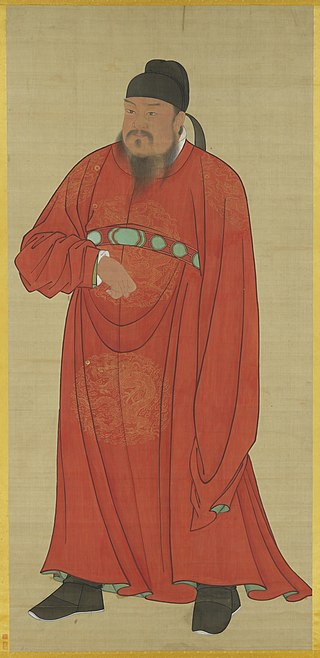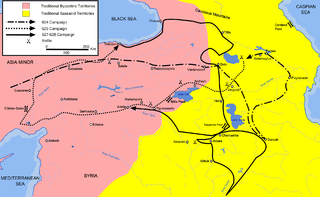
Year 622 (DCXXII) was a common year starting on Friday of the Julian calendar, the 622nd year of the Common Era (CE) and Anno Domini (AD) designations, the 622nd year of the 1st millennium, the 22nd year of the 7th century, and the 3rd year of the 620s decade. The denomination 622 for this year has been used since the early medieval period, when the Anno Domini calendar era became the prevalent method in Europe for naming years.
The 620s decade ran from January 1, 620, to December 31, 629.
The 610s decade ran from January 1, 610, to December 31, 619.
The 570s decade ran from January 1, 570, to December 31, 579.
The 580s decade ran from January 1, 580, to December 31, 589.

Year 624 (DCXXIV) was a leap year starting on Sunday of the Julian calendar. The denomination 624 for this year has been used since the early medieval period, when the Anno Domini calendar era became the prevalent method in Europe for naming years.

Year 626 (DCXXVI) was a common year starting on Wednesday of the Julian calendar. The denomination 626 for this year has been used since the early medieval period, when the Anno Domini calendar era became the prevalent method in Europe for naming years.

Year 613 (DCXIII) was a common year starting on Monday of the Julian calendar. The denomination 613 for this year has been used since the early medieval period, when the Anno Domini calendar era became the prevalent method in Europe for naming years.

Year 616 (DCXVI) was a leap year starting on Thursday of the Julian calendar. The denomination 616 for this year has been used since the early medieval period, when the Anno Domini calendar era became the prevalent method in Europe for naming years.

Year 618 (DCXVIII) was a common year starting on Sunday of the Julian calendar. The denomination 618 for this year has been used since the early medieval period, when the Anno Domini calendar era became the prevalent method in Europe for naming years.

Year 619 (DCXIX) was a common year starting on Monday of the Julian calendar. The denomination 619 for this year has been used since the early medieval period, when the Anno Domini calendar era became the prevalent method in Europe for naming years.

Year 582 (DLXXXII) was a common year starting on Thursday of the Julian calendar. The denomination 582 for this year has been used since the early medieval period, when the Anno Domini calendar era became the prevalent method in Europe for naming years.

Shahrbaraz, was shah (king) of the Sasanian Empire from 27 April 630 to 9 June 630. He usurped the throne from Ardashir III, and was killed by Iranian nobles after forty days. Before usurping the Sasanian throne he was a spahbed (general) under Khosrow II (590–628). He is furthermore noted for his important role during the climactic Byzantine–Sasanian War of 602–628, and the events that followed afterwards.
Shahen or Shahin was a senior Sasanian general (spahbed) during the reign of Khosrow II (590–628). He was a member of the House of Spandiyadh.

The siege of Constantinople in 626 by the Sassanid Persians and Avars, aided by large numbers of allied Slavs, ended in a strategic victory for the Byzantines. The failure of the siege saved the empire from collapse, and, combined with other victories achieved by Emperor Heraclius the previous year and in 627, enabled Byzantium to regain its territories and end the destructive Roman–Persian Wars by enforcing a treaty with borders status quo c. 590.

Philippicus was an Eastern Roman general, comes excubitorum, and brother-in-law of Emperor Maurice. His successful career as a general spanned three decades, chiefly against the Sassanid Persians.

The Byzantine–Sasanian War of 602–628, also called the Last Great War of Antiquity, was fought between the Byzantine Empire and the Sasanian Empire. It was the final and most devastating conflict of the Roman–Persian Wars. The previous war between the two powers had ended in 591 after emperor Maurice helped the Sasanian King Khosrow II regain his throne. In 602, Maurice was murdered by his political rival Phocas. Khosrow declared war, ostensibly to avenge the death of the deposed emperor Maurice. This became a decades-long conflict, the longest war in the series, and was fought throughout the Middle East, the Aegean Sea, and before the walls of Constantinople itself.
Theodore was the brother of the Byzantine emperor Heraclius, a curopalates and leading general in Heraclius' wars against the Persians and against the Muslim conquest of the Levant.
The 600s decade ran from January 1, 600, to December 31, 609.

Heraclius' Caucasus campaign was an invasion of the Byzantine army into the Caucasus, which belonged to the Sassanids at that time, took place in the period from 624 to 625, as a result, the Greeks captured the Transcaucasia.













